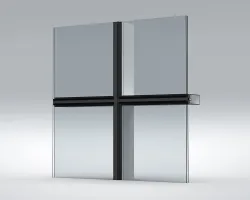Dec. 11, 2023
Construction & Real Estate
A hidden frame glass curtain wall refers to a modern architectural design where the structural framework supporting the glass panels is concealed, creating a seamless and minimalist appearance. This type of curtain wall system is often used in contemporary buildings to achieve a sleek and aesthetically pleasing exterior. Here are key features and characteristics of a hidden frame glass curtain wall:
1. Structural Concealment:
The defining feature of a hidden frame glass curtain wall is the concealment of the structural framework behind the glass panels. This creates a clean and unobstructed visual effect, emphasizing transparency and modern design.
2. Minimalist Aesthetics:
Hidden frame curtain walls contribute to a minimalist aesthetic, promoting an open and airy feel in both the interior and exterior of a building. The absence of visible frames allows for uninterrupted views and a sleek, contemporary appearance.
3. Glass Panels:
Glass panels are a prominent element in a hidden frame curtain wall. These panels are typically large and can vary in thickness, providing natural light, energy efficiency, and a connection between the interior and exterior spaces.
4. Structural Support:
Despite the concealed frame, hidden frame curtain walls are engineered to provide structural support and stability. Structural elements are integrated within the building's framework to ensure the safety and durability of the entire system.

5. Versatility:
Hidden frame glass curtain walls are versatile and can be customized to suit various architectural designs. They can be integrated into buildings with different shapes and sizes, offering flexibility in terms of design possibilities.
6. Thermal Performance:
To address energy efficiency concerns, hidden frame curtain walls often incorporate thermal breaks and insulating materials. This helps enhance the building's overall thermal performance, contributing to energy conservation.
Suggested reading:7. Installation Challenges:
Installing hidden frame curtain walls can be more complex compared to traditional curtain wall systems, as precision is crucial to achieve the desired seamless appearance. Proper installation ensures the alignment and integrity of the glass panels.
8. Maintenance Considerations:
While the design minimizes visible framing that requires maintenance, the glass panels may still require regular cleaning and upkeep. Access for maintenance purposes should be carefully planned during the design phase.
9. Integration with Building Systems:
Hidden frame glass curtain walls need to integrate seamlessly with other building systems, such as ventilation, lighting, and shading, to ensure functionality and efficiency.
10. Popular in Modern Architecture:
- Hidden frame glass curtain walls are often associated with modern and contemporary architectural styles. They are frequently used in commercial buildings, high-rise structures, and upscale residences seeking a sophisticated and open design.
In summary, a hidden frame glass curtain wall represents a design approach that emphasizes transparency, modern aesthetics, and a connection between indoor and outdoor spaces. Its popularity in contemporary architecture reflects a commitment to sleek, minimalist design principles.
More articles:
Hydroxypropylmethylcellulose: Unlocking the Potential of Multifunctional Compounds
What Is The Fill Material in a Cooling Tower?
Exploring the Advantages of Framing Membrane Structures
Previous: What tape works best in the cold?
Next: Are there any eco-friendly features in GFS Water Storage Tanks?
If you are interested in sending in a Guest Blogger Submission,welcome to write for us!
All Comments ( 0 )